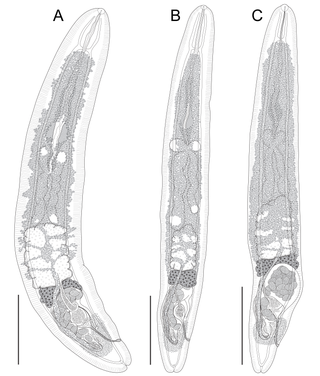
Digenea is a class of trematodes in the Platyhelminthes phylum, consisting of parasitic flatworms with a syncytial tegument and, usually, two suckers, one ventral and one oral. Adults commonly live within the digestive tract, but occur throughout the organ systems of all classes of vertebrates. Once thought to be related to the Monogenea, it is now recognised that they are closest to the Aspidogastrea and that the Monogenea are more closely allied with the Cestoda. Around 6,000 species have been described to date.
Cyclocoelidae is a family of trematodes in the order Plagiorchiida.

Plagiorchiida is a large order of trematodes, synonymous to Echinostomida. They belong to the Digenea, a large subclass of flukes. This order contains relatively few significant parasites of humans.

Zoogonidae are a family of trematodes in the order Plagiorchiida.

Opecoelidae is a family of trematodes. It is the largest digenean family with over 90 genera and nearly 900 species, almost solely found in marine and freshwater teleost fishes. It was considered by Bray et al. to belong in the superfamily Opecoeloidea Ozaki, 1925 or the Brachycladioidea Odhner, 1905.

Hamacreadium is a genus of trematodes in the family Opecoelidae. It is synonymous with Olivacreadium Bilqees, 1976. Species of Hamacreadium are endoparasitic in fish such as Lethrinus Cuvier, 1829.
Cainocreadium is a genus of trematodes in the family Opecoelidae. It has been synonymised with Apopodocotyle Pritchard, 1966, Cainocreadoides Nagaty, 1956, and Emmettrema Caballero y Caballero, 1946.
Dactylostomum is a genus of trematodes in the family Opecoelidae. It is synonyised with Opedunculata Dwivedi, 1975.

Helicometra is a genus of trematodes in the class Opecoelidae. It is synonymous with AllostenoperaBaeva, 1968, MetahelicometraYamaguti, 1971, and StenoperaManter, 1933. Its type species is H. fasciata(Rudolphi, 1819). They are distinguished by their unique spiral uterus, from which their name is derived.
Neohelicometra is a genus of trematodes in the family Opecoelidae. It consists of only one species, Neohelicometra scorpaenae Siddiqi & Cable, 1960.
Opecoeloides is a genus of trematodes in the family Opecoelidae. It has been synonymised with Cymbephallus Linton, 1934 and Fimbriatus von Wicklen, 1946.
Transversotrematidae is a family of trematodes in the order Plagiorchiida. It is the only family in the superfamily Transversotrematoidea, which is the only superfmaily in the suborder Transversotremata. It has been synonymised with Circuitiocoeliidae Wang, 1981, Squamacolidae Pan & Wang, 1985, and Transversotrematinae Witenberg, 1944.
Acanthotrema is a genus of trematodes in the family Heterophyidae.
Aspidogastrida is an order of trematodes in the subclass Aspidogastrea.
Aephnidiogenidae is a family of trematodes in the order Plagiorchiida.
Holorchis is a genus of trematodes in the family Aephnidiogenidae.

Aporocotylidae is a family of trematodes within the order Diplostomida, which contains species commonly known as fish blood flukes. It contains more than 40 genera, the largest being Cardicola. Species in this family parasite fish in both fresh and marine water.

Xiphidiata is a suborder of Plagiorchiida, an order of parasitic flatworms (flukes).
Batrachotrematidae is a family of trematodes in the order Plagiorchiida.





